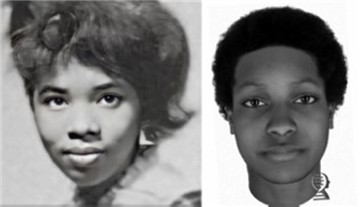PORTLAND, OR – The Oregon State Police is reporting that: Through dedicated inter-agency cooperation, the remains of a previously unidentified young woman have been identified as Sandra Young, a Portland teenager who went missing from the Portland metro area more than five decades ago. The young woman was a Grant High School student and had not been seen since 1968 or 1969.
“Sandra Young has now regained her identity after 54 years,” said Dr. Nici Vance, the state’s Human Identification Program Coordinator at the Oregon State Medical Examiner’s Office. “Her story represents a remarkable amount of diligence and collaboration between family members, detectives, Oregon State Medical Examiner staff, and our contract laboratory Parabon Nanolabs. This is yet another example of the innovative ways the ME’s Office and investigative genetic genealogy can help Oregonians find closure. This technology gives investigators the powerful ability to assist all Oregon agencies with the resolution of their cold case mysteries,” Dr. Vance continued. On Feb. 23, 1970, the remains of a fully skeletonized young female were discovered buried in a shallow grave at the far north end of Sauvie Island in Columbia County. The discovery was made by a Boy Scout troop leader, who first saw what he thought were items of clothing and then discovered human remains within the grave. Investigators recovered the remains and the remnants of a black curly wig. Investigators believed the remains were that of an African American and trauma to the body indicated foul play.The young decedent, still unidentified, was moved to the state medical examiner facility in Clackamas County in 2004 along with more than 100 additional sets of unidentified remains. An anthropology report was completed, a bone sample was submitted to the University of North Texas Center for Human Identification, and a NamUs profile was created.The case was the subject of consistent attention by the state medical examiner’s office. DNA results had been uploaded into CODIS, but no genetic associations were discovered. The DNA results indicated the remains were, in fact, that of a female. The NamUs system was checked for new cases of missing teenagers and young adult women on the West Coast, but none appeared to match the decedent. The National Center for Missing and Exploited Children (NCMEC) picked up the case and provided media attention and a more thorough review of additional missing person websites. DNA results only indicated that the remains were female in origin.In 2018, the Oregon State Police Medical Examiner’s Office was awarded a National Institute of Justice grant to perform innovative DNA techniques on unsolved unidentified skeletal remains cases. This case was recognized as one that could potentially be resolved by DNA Phenotyping and Investigative Genetic Genealogy provided by OSP’s contract lab, Parabon NanoLabs.An additional bone sample was submitted for DNA extraction, and a single-nucleotide polymorphism (SNP) DNA profile was successfully analyzed.The first Parabon Nanolabs report to be completed was a DNA Snapshot© Report, where genetic material is used to determine eye color, hair color, skin color, and the ancestry of the deceased. The report predicted this individual was of West African, South African, and Northern European descent, with brown to dark brown skin, brown eyes, and black hair.The subsequent investigative genetic genealogy report, unfortunately, showed the lack of promising leads in the now 50-year-old cold case. Recommendations and contacts were made, but additional follow-up was slow.Further analysis was performed by Parabon NanoLabs, with encouraging results. In February 2021, a deeper genetic dive was taken into the young woman’s ancestry, and a prediction of her facial characteristics was created. “To see her face come to life through DNA phenotyping was striking,” said Dr. Vance. In January 2023, an individual uploaded their DNA into the open-source genetic genealogy database GEDMatch and immediately was recognized as a potential distant family member of the decedent. Through research and interviews, the genetic genealogist encouraged other members of the family to upload their DNA data into GEDMatch, and a more complete picture of heritage emerged.In July 2023 an additional Parabon report was completed. Descendants and countless family trees were developed; more matches came to light and communication with family members indicated that a teenage girl named Sandra Young went missing from Portland around the time the decedent was discovered. Sandra was a Grant High School student and appeared to be the sister of one of the genetic matches who, when contacted by the genealogist, agreed to assist in uploading their DNA data into GEDMatch.Because Sandra was last seen in Portland, the Portland Police Bureau was contacted for assistance. PPB Detective Heidi Helwig took information from the Investigative Genetic Genealogy (IGG) report and contacted the DNA donor. Through a series of informative, poignant, and difficult interviews, Detective Helwig learned that this individual not only lost a teenage sister when Sandra went missing in 1968 or 1969, they also lost a sister to gun violence in the 1970s. The family member was cooperative, supportive, and motivated to determine if the remains could be their sister, Sandra Young.In October 2023, the Kinship Inference Report was definitive in its conclusions. Genetic evidence confirmed the hypothesis that the young decedent was Sandra “Sandy” Young, born June 25, 1951, and unaccounted for since 1968 or 1969.Based on the totality of the evidence (both genetic and circumstantial) Oregon Chief Medical Examiner Dr. Sean Hurst positively identified the individual as Sandra Young and the next-of-kin has been notified. The PPB detective division is now aware of the case and has been encouraged to conduct further investigation to determine, if possible, the circumstances of Sandy Young’s death.Significant resources are needed to continue this type of advanced testing at the State Medical Examiner’s Office. Genetic genealogy casework and confirmation testing have shown incredibly successful results but can cost between $6,000-$10,000 per case. The State Medical Examiner’s Office is eager to continue the good work of identifying unknown decedents once again if funding is secured for future testing.
# # #










